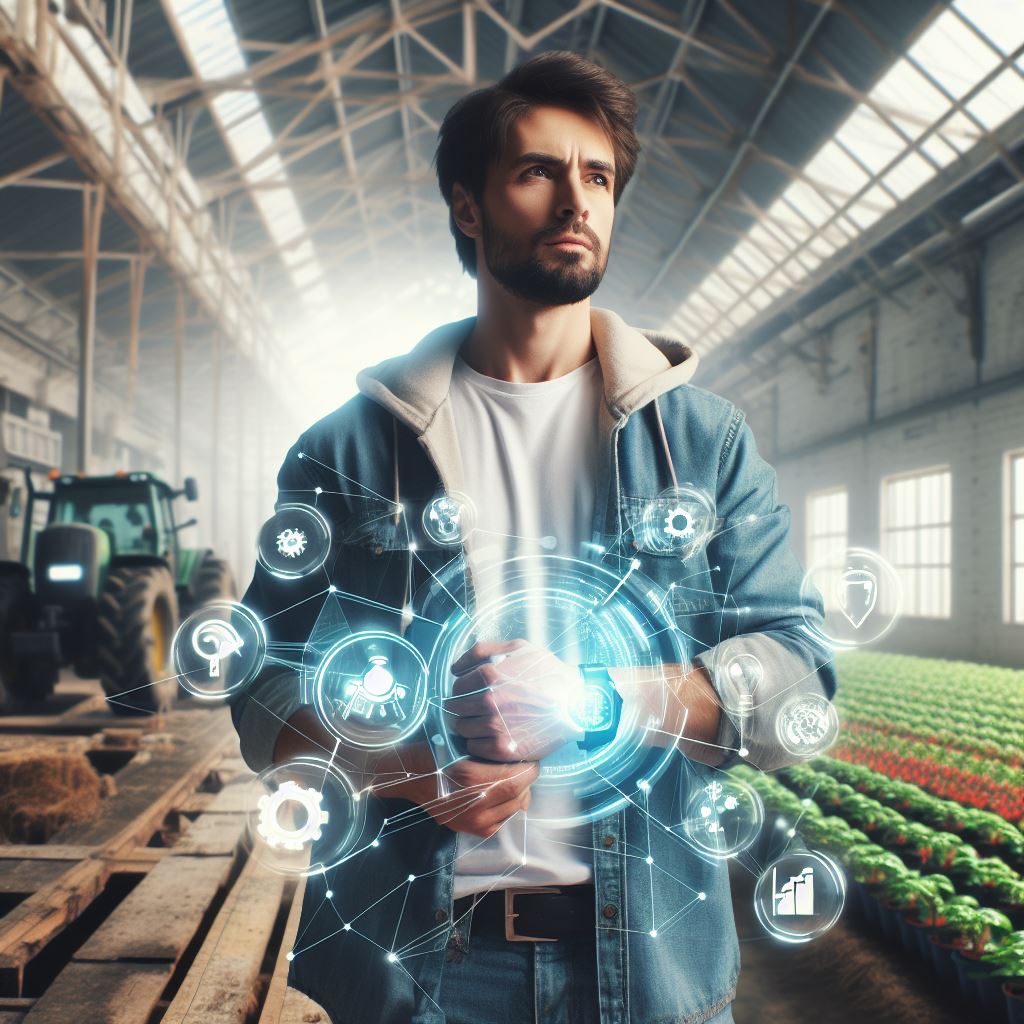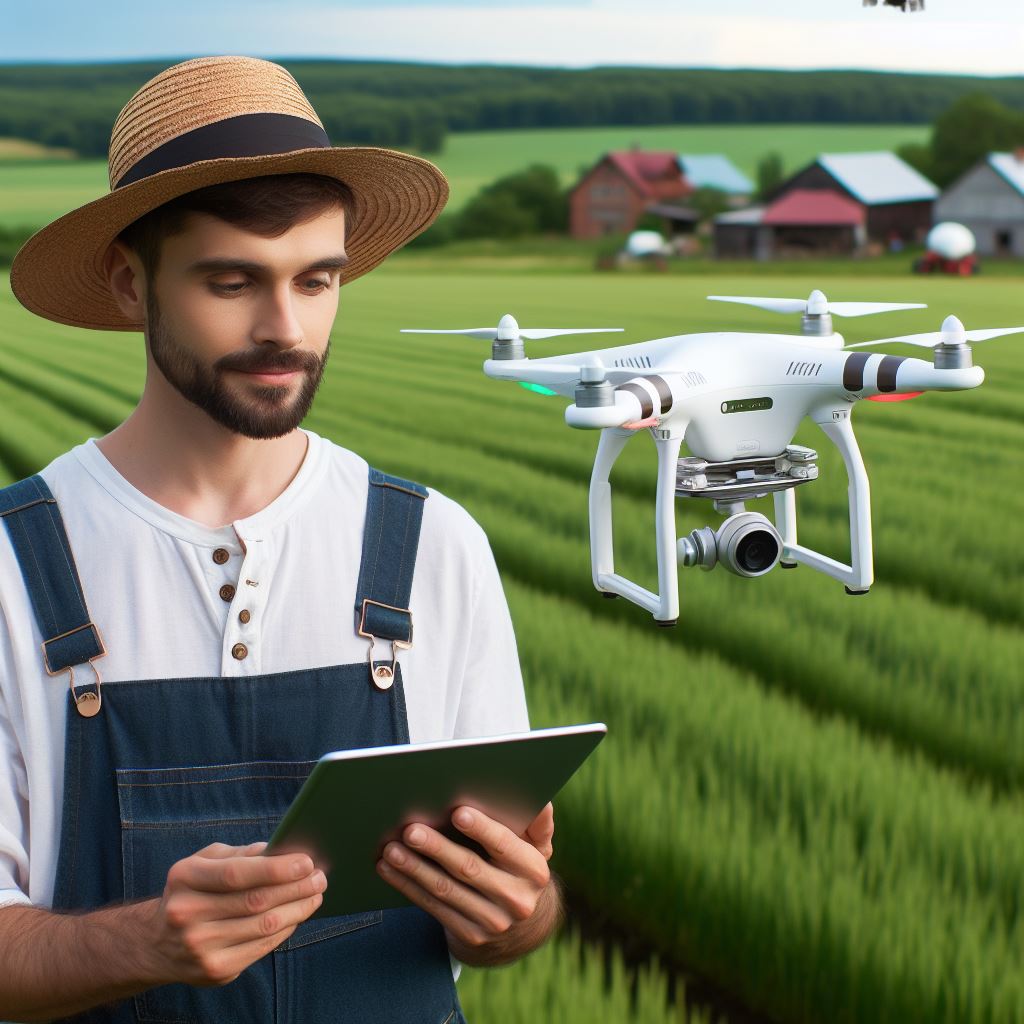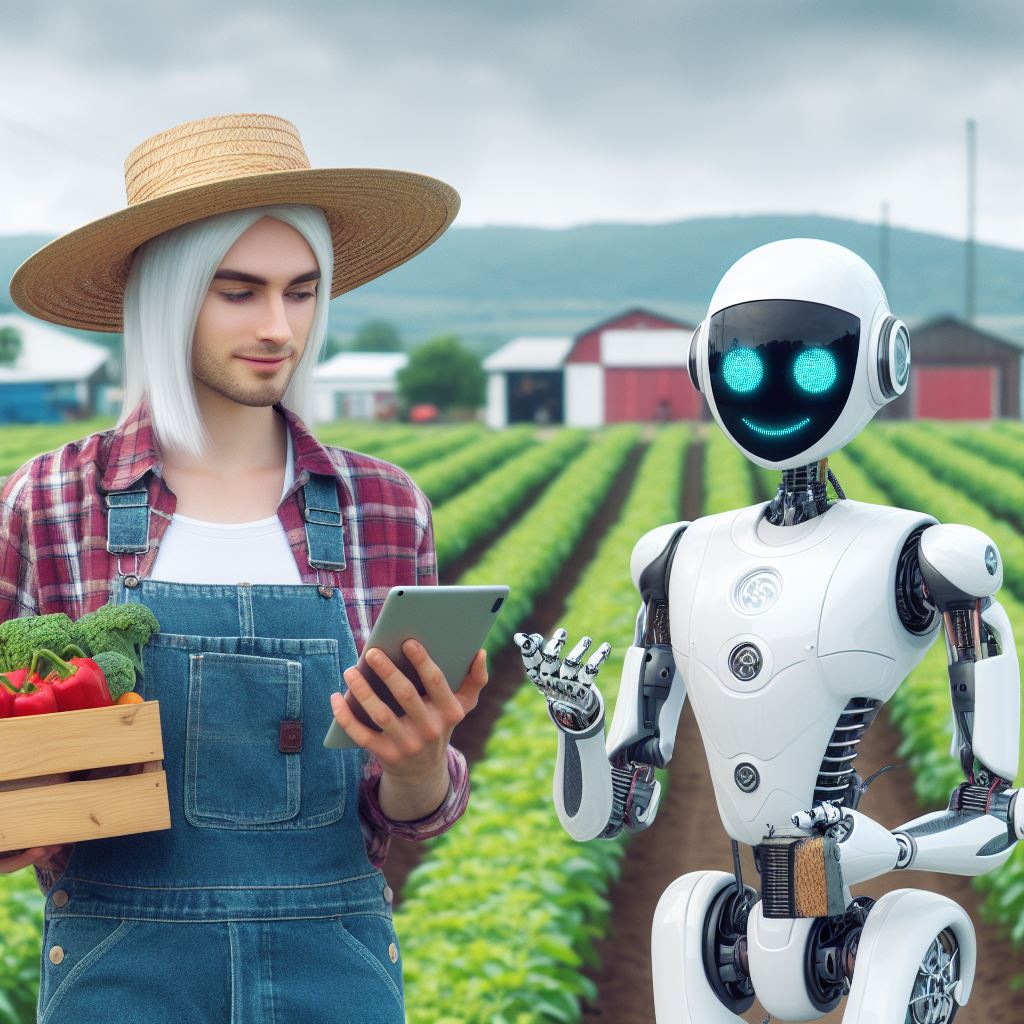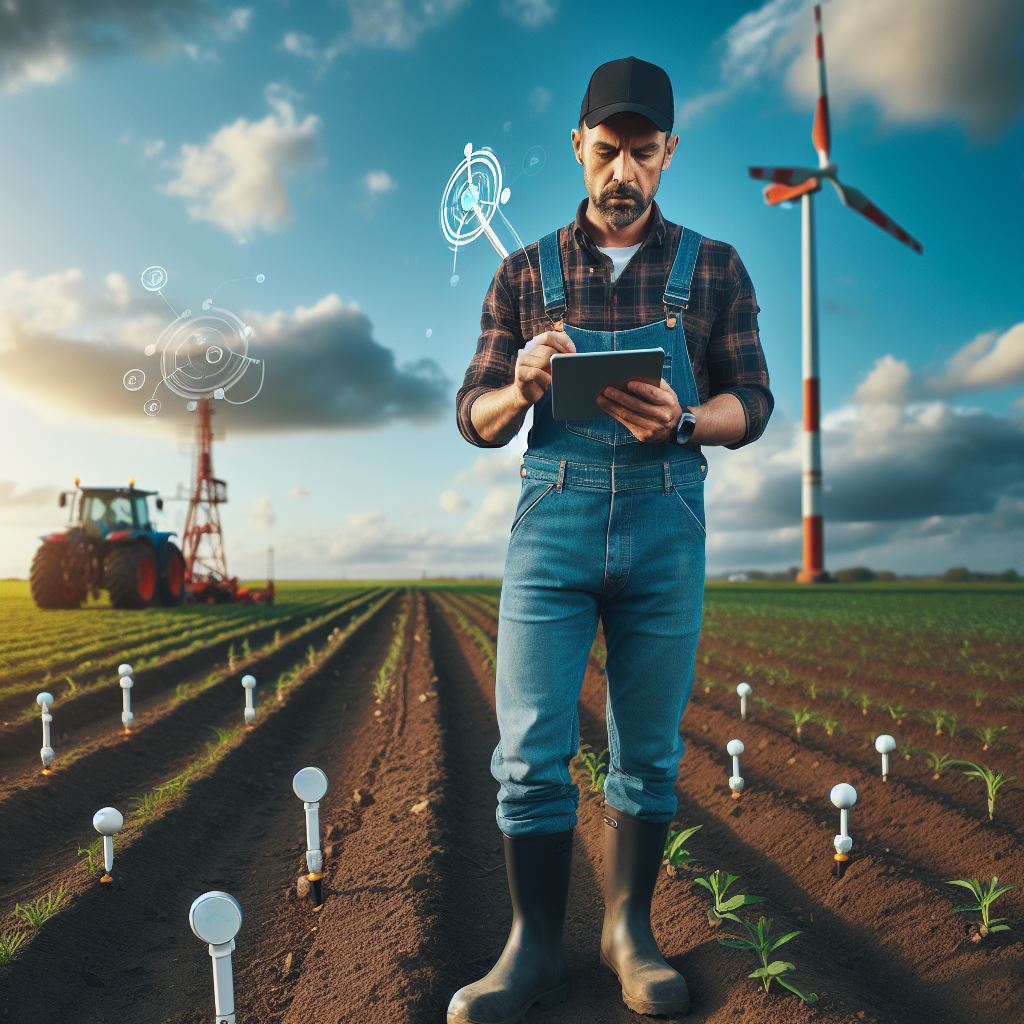Introduction
In recent years, the agriculture industry has witnessed a remarkable transformation with the introduction of smart farming technologies.
These technologies encompass a range of innovative solutions that leverage the power of automation, data analytics, and connectivity to optimize farming practices.
Understanding the rise of these technologies is essential to comprehend their importance in shaping the future of agriculture.
Smart farming technologies have revolutionized the way farmers approach their work.
Traditional farming methods are being replaced by sophisticated systems that rely on sensors, drones, and artificial intelligence to monitor crops, livestock, and farm operations.
These technologies enable precise measurements of key parameters like soil moisture, temperature, and nutrient levels, allowing farmers to make data-driven decisions for improved productivity and sustainability.
The rise of these technologies is not just a matter of convenience; it has become a necessity.
With the world’s population expected to reach 9.7 billion by 2050, the demand for food will escalate significantly.
Smart farming technologies offer the potential to meet this demand efficiently and sustainably.
By optimizing resource utilization and reducing waste, these technologies can contribute to sustainable agriculture practices and ensure food security for future generations.
Moreover, analyzing the rise of smart farming technologies is crucial because it presents numerous opportunities for farmers and agricultural stakeholders.
These technologies can enhance crop yields, reduce production costs, and minimize environmental impact.
Furthermore, they provide farmers with real-time data and insights, enabling them to make proactive decisions, mitigate risks, and optimize their operations.
In short, smart farming technologies have become a game-changer in agriculture.
Understanding their rise and importance is vital for farmers and stakeholders to leverage these transformative solutions and pave the way for a more sustainable and productive future in farming.
Transform Your Agribusiness
Unlock your farm's potential with expert advice tailored to your needs. Get actionable steps that drive real results.
Get StartedDefinition and Types of Smart Farming Technologies
What smart farming technologies entail
Smart farming technologies refer to the use of advanced technological tools and systems in farming practices.
They aim to improve efficiency, productivity, and sustainability in agricultural production.
These technologies utilize various sensors, devices, and software to collect and analyze data in real-time.
The data obtained is used to make informed decisions and optimize farming operations.
Overview of the different types of smart farming technologies
Precision agriculture
Precision agriculture involves the use of GPS, drones, and sensors to manage crop and soil variables.
Farmers can monitor and control factors like irrigation, fertilization, and pest control with precision.
This technology helps in optimizing resource allocation, reducing waste, and increasing yield.
Internet of Things (IoT) applications
IoT applications in smart farming enable seamless connectivity between devices, machines, and farm management systems.
Sensors and actuators are used to collect data on crop growth, weather conditions, and soil moisture.
This data is transmitted and analyzed to make real-time adjustments and maximize agricultural productivity.
Robotics and automation
Robotic systems can perform agricultural tasks such as planting, harvesting, and weeding autonomously.
These robots are equipped with sensors, cameras, and algorithms to navigate the farm and execute tasks precisely.
Automation in smart farming reduces labor requirements, improves accuracy, and enhances overall efficiency.
Big data analytics and artificial intelligence
Big data analytics and artificial intelligence techniques are used to process and analyze vast amounts of agricultural data.
These technologies help in identifying patterns, predicting crop diseases, optimizing irrigation schedules, and improving yield.
By leveraging AI algorithms, farmers can make data-driven decisions and achieve better crop management outcomes.
Drones and remote sensing
Drones and remote sensing technologies provide valuable insights into crop health, nutrient deficiencies, and pest infestations.
Equipped with cameras and sensors, drones can capture high-resolution images and multispectral data.
Farmers use this information to detect early signs of stress, make targeted interventions, and prevent yield losses.
Smart farming technologies have revolutionized the agricultural sector by enabling precision, automation, and data-driven decision-making.
These technologies empower farmers to overcome challenges such as limited resources, climate change, and increasing food demand.
By adopting smart farming practices, farmers can optimize resource utilization, reduce environmental impact, and achieve sustainable agricultural production.
Read: AI and Agri: The Future of Crop Management
Benefits and Advantages of Smart Farming Technologies
Increased efficiency and productivity
Smart farming technologies revolutionize traditional agricultural practices, leading to increased efficiency and productivity levels on farms.
Showcase Your Farming Business
Publish your professional farming services profile on our blog for a one-time fee of $200 and reach a dedicated audience of farmers and agribusiness owners.
Publish Your ProfileThese technologies integrate automation, data analytics, and real-time monitoring systems to streamline processes.
By automating tasks such as planting, irrigation, and fertilization, farmers can save a significant amount of time and effort.
This allows them to focus on more critical aspects of their operations, such as crop monitoring and pest management.
Additionally, smart farming technologies provide farmers with valuable insights and data-driven recommendations, enabling them to make more informed decisions regarding crop management and resource allocation.
Resource optimization and environmental sustainability
Using smart farming technologies, farmers can optimize the use of resources and promote environmental sustainability.
These technologies enable precise and targeted application of resources such as water, fertilizers, and pesticides.
By employing sensors, drones, and satellite imagery, farmers can monitor the condition of their crops in real-time and apply resources only where and when they are needed.
This reduces wastage and minimizes the environmental impact of farming practices.
Moreover, smart farming technologies promote sustainable farming practices by minimizing soil erosion, conserving water, and reducing chemical usage.
This not only benefits the environment but also ensures the long-term viability of agricultural operations.
Enhanced decision-making and predictive analytics
Smart farming technologies leverage advanced analytics and predictive modeling to provide farmers with valuable insights for decision-making.
By analyzing data collected from various sources such as weather stations, sensors, and drones, these technologies can forecast crop yield, disease outbreaks, and market trends.
Armed with this information, farmers can make proactive decisions regarding planting, harvesting, and selling their produce.
They can also anticipate and mitigate potential risks, resulting in better financial outcomes and improved overall farm management.
Improved crop and livestock management
Smart farming technologies offer numerous advantages for crop and livestock management.
These technologies enable precise monitoring of factors like soil conditions, temperature, humidity, and livestock behavior.
By continuously monitoring these parameters, farmers can make real-time adjustments and optimize their farming practices.
This leads to healthier crops and livestock, improved product quality, and increased profitability.
Furthermore, smart farming technologies enhance disease detection and prevention in crops and livestock.
Early detection allows farmers to take prompt action, minimizing losses and reducing the need for extensive chemical treatments.
Reduction in labor requirements and cost savings
Smart farming technologies reduce labor requirements on farms through automation and remote monitoring.
Tasks that previously required manual labor can now be performed by machines or remotely managed through connected systems.
Automated processes not only save time but also reduce the need for a large workforce, leading to significant cost savings for farmers.
The reduced labor costs allow farmers to invest in other areas of their operations or allocate resources towards technological advancements.
Additionally, smart farming technologies improve operational efficiency and reduce the risk of human error, resulting in improved overall farm productivity and profitability.
In fact, smart farming technologies offer a multitude of benefits and advantages for farmers.
From increased efficiency and productivity to resource optimization and cost savings, these technologies are transforming the agricultural industry and paving the way for a more sustainable and technologically advanced future.
Read: GPS in Farming: How It Revolutionizes Agriculture
Case Studies: Successful Implementations of Smart Farming Technologies
In this section, we will delve into two noteworthy case studies that showcase the successful implementation of smart farming technologies.
These examples highlight the transformative impact of precision agriculture in crop farming and IoT applications in livestock management.
Example 1: Precision agriculture in crop farming
Description of the technology and its benefits
Precision agriculture revolutionizes traditional crop farming practices by integrating cutting-edge technologies such as drones, satellite imagery, and sensors.
These technologies enable farmers to collect real-time data about soil conditions, pest infestations, and crop growth.
By analyzing this data, farmers can make informed decisions regarding precise interventions, thereby optimizing resource allocation and minimizing waste.
The benefits of precision agriculture are extensive. Firstly, it enhances productivity by maximizing crop yields.
By tailoring treatments such as irrigation, fertilization, and pesticide usage based on specific field characteristics, crops receive precisely what they need at the right time, leading to improved growth and health.
This approach eliminates the overuse of resources, resulting in cost savings for farmers.
Furthermore, precision agriculture promotes sustainability by reducing environmental impact.
By maintaining soil health, preventing excessive fertilizer runoff, and minimizing pesticide usage, it helps conserve soil quality and water resources.
This sustainable approach contributes to a healthier ecosystem and preserves natural resources for future generations.
Real-world example of a farm implementing precision agriculture
Farm X, a medium-sized farm specializing in corn production, faced challenges related to unpredictable weather patterns and varying soil conditions across their fields.
Showcase Your Farming Business
Publish your professional farming services profile on our blog for a one-time fee of $200 and reach a dedicated audience of farmers and agribusiness owners.
Publish Your ProfileSeeking solutions, they decided to implement precision agriculture techniques in collaboration with a prominent technology company.
Initially, Farm X collected data from soil moisture sensors, aerial imagery, and weather forecasts.
The data was then analyzed using advanced algorithms to generate customized treatment plans for each field.
By employing drone technology, the farm initiated targeted interventions such as variable-rate irrigation and precise fertilization.
The results were remarkable. Farm X experienced a 20% increase in corn yield compared to previous years.
Additionally, the farm significantly reduced water consumption and fertilizer usage, resulting in substantial cost savings.
The precise treatments helped address issues promptly, preventing crop losses and ensuring optimal harvests.
Farm X became a prime example of how precision agriculture can transform traditional farming practices to achieve higher yields, economic viability, and environmental sustainability.
Example 2: IoT applications in livestock management
Explanation of the technology and its advantages
IoT applications have revolutionized livestock management by empowering farmers to monitor and manage their animals more effectively.
Through the use of sensors, wearables, and data analytics, real-time information about animal health, behavior, and productivity can be gathered.
This data-driven approach enables farmers to make informed decisions, ensuring the overall well-being and productivity of their livestock.
One of the key advantages of IoT applications in livestock management is improved animal health.
By continuously monitoring vital signs such as heart rate, body temperature, and rumination, farmers can detect early signs of illness or distress.
Prompt intervention reduces disease occurrence, minimizes the need for antibiotics, and improves overall animal welfare.
Additionally, IoT technology enables precise tracking of animals, increasing safety and preventing loss.
GPS devices and geofencing systems help farmers monitor the location and movement of livestock.
This feature proves valuable during grazing, as it alerts farmers if animals stray from designated areas or encounter potential hazards.
Furthermore, IoT in livestock management optimizes feeding schedules and resource management.
By analyzing animal behavior patterns and nutritional needs, farmers can develop customized feeding plans and prevent overfeeding.
This not only reduces costs but also enhances the efficiency of feed utilization, contributing to improved productivity.
Case study showcasing successful utilization of IoT in livestock farming
Farm Y, a dairy farm specializing in cattle breeding, faced challenges in monitoring the health and location of their animals.
They implemented IoT technology to overcome these hurdles and improve overall livestock management.
By equipping their cows with wearable sensors, Farm Y was able to continuously monitor vital signs, activity levels, and feeding patterns of each individual animal.
This real-time data was transmitted to a central dashboard, allowing the farm managers to track the health and behavior of their cattle effortlessly.
Automated alerts were generated if any deviations from normal patterns were detected.
The implementation of IoT technology resulted in significant improvements.
Farm Y witnessed a 30% decrease in disease occurrence, as early warning signs were promptly identified and appropriate actions were taken.
Furthermore, the precise monitoring of feeding patterns enabled the farm to optimize feeding schedules, resulting in reduced feed costs.
The technology also facilitated the identification of potential issues, such as inadequate grazing areas, leading to improved overall animal welfare.
In general, these case studies provide compelling evidence of the benefits and success of smart farming technologies in the agriculture industry.
Precision agriculture and IoT applications in crop farming and livestock management have proven instrumental in improving yields, resource efficiency, and sustainability.
As technology continues to evolve, it is essential for farmers to embrace these innovations and unlock their full potential to meet the challenges of an ever-changing agricultural landscape.
Read: Climate-Smart Farming Innovations

Explore Further: Tech for Organic Farming in 2024
Challenges and Limitations of Smart Farming Technologies
Initial investment costs and access to technology
One of the major challenges in implementing smart farming technologies is the high initial investment costs that farmers have to bear.
The cost of purchasing and installing advanced machinery, sensors, and other equipment can be quite substantial.
Additionally, access to technology can be a limiting factor.
Many small-scale farmers, particularly in developing countries, may not have the financial resources or infrastructure required to adopt and integrate smart farming technologies into their operations.
As a result, there is a digital divide between farmers who can afford and have access to these technologies, and those who cannot.
This divide can further exacerbate existing socioeconomic inequalities in the agricultural sector.
Showcase Your Farming Business
Publish your professional farming services profile on our blog for a one-time fee of $200 and reach a dedicated audience of farmers and agribusiness owners.
Publish Your ProfileTraining and skill acquisition for farmers
Another challenge is the need for farmers to acquire the necessary training and skills to effectively use smart farming technologies.
The successful adoption and utilization of these technologies require farmers to have a good understanding of data interpretation, sensor operation, and precision agriculture techniques.
Training programs and workshops aimed at educating farmers on the use of these technologies are essential.
However, ensuring widespread access to such training can be a logistical and financial challenge.
The lack of skilled personnel who can provide technical support and guidance to farmers further compounds this issue.
It is crucial to bridge the knowledge gap and provide adequate support to farmers to maximize the potential benefits of smart farming technologies.
Data security and privacy concerns
With the increasing reliance on data collection and analysis in smart farming, data security and privacy concerns have become prominent.
Smart farming technologies generate vast amounts of data, including sensitive information about farm operations and production.
Farmers worry about the unauthorized access, misuse, or theft of their data.
They also have concerns about the potential for data breaches and how such incidents could affect their competitiveness in the market.
Ensuring robust and secure data management systems, implementing encryption and authentication measures, and establishing clear data ownership and access rights are crucial in addressing these concerns.
Awareness campaigns and guidelines on data protection can also help instill confidence among farmers.
Potential dependency on technology and loss of traditional farming practices
While smart farming technologies offer immense potential for improving productivity and efficiency, there is a concern about overreliance and the potential loss of traditional farming practices.
Traditional farming practices, passed down through generations, have unique cultural and ecological significance.
Overdependence on technology may lead to the fading away of these traditional practices, resulting in the loss of valuable knowledge and biodiversity.
It is essential to strike a balance between adopting new technologies and preserving traditional farming techniques.
This can be achieved by integrating smart farming technologies with existing practices and ensuring farmers have the autonomy to make informed decisions about their farming methods.
Moreover, promoting sustainable agriculture practices and agroecology can help preserve biodiversity and minimize the negative impacts associated with excessive technological dependency.
In essence, while smart farming technologies offer numerous benefits, several challenges and limitations need to be addressed for their widespread adoption.
The high initial investment costs and limited access to technology hinder small-scale farmers.
Training and skill acquisition, data security and privacy concerns, and the potential loss of traditional farming practices and biodiversity are other significant challenges.
By addressing these challenges, stakeholders can create an enabling environment for smart farming technologies to revolutionize the agricultural sector.
Read: Precision Ag: Revolutionizing Farms
Future Trends and Opportunities in Smart Farming Technologies
Integration of emerging technologies like blockchain and machine learning
One of the future trends in smart farming technologies is the integration of emerging technologies such as blockchain and machine learning.
These technologies have the potential to revolutionize the agriculture industry by providing efficient and transparent solutions.
Adoption of smart sensors and real-time data monitoring
Smart farming technologies will also see the increased adoption of smart sensors and real-time data monitoring.
These sensors can provide farmers with valuable insights into their crops and livestock, allowing them to make informed decisions and optimize their farming practices.
Potential for collaboration between farmers and technology companies
There is a great potential for collaboration between farmers and technology companies in the development and implementation of smart farming technologies.
By working together, both parties can leverage their expertise to create innovative solutions that address the challenges faced by the agriculture industry.
Expansion of smart farming technologies in developing countries
Smart farming technologies are not limited to developed countries.
There is a significant opportunity for the expansion of these technologies in developing countries, where they can help improve food security, increase productivity, and reduce waste.
As the agriculture industry continues to evolve, smart farming technologies will play a crucial role in shaping its future.
The integration of emerging technologies like blockchain and machine learning will enable farmers to streamline their operations and improve overall efficiency.
By adopting smart sensors and real-time data monitoring, farmers can gain a deeper understanding of their crops and make data-driven decisions.
The potential collaboration between farmers and technology companies can lead to the development of innovative solutions that address the unique challenges faced by the agriculture industry.
And finally, the expansion of smart farming technologies in developing countries can bring about numerous benefits, such as improved food security and increased productivity.
With these future trends and opportunities, the rise of smart farming technologies is set to continue and revolutionize the agriculture industry.
Farmers and technology companies alike should embrace these advancements and work together to create a sustainable and efficient future for farming.
Conclusion
Recap of the key points discussed:
- Smart farming technologies are revolutionizing the agricultural industry.
- These technologies include IoT, sensors, drones, and data analytics.
- They enable precision farming, optimizing resource utilization and crop yield.
- Smart farming technologies also improve livestock management and reduce waste.
As demonstrated, smart farming technologies have immense potential for sustainable agricultural practices.
Showcase Your Farming Business
Publish your professional farming services profile on our blog for a one-time fee of $200 and reach a dedicated audience of farmers and agribusiness owners.
Publish Your ProfileBy improving efficiency, reducing costs, and minimizing environmental impact, these technologies play a vital role in securing the future of agriculture.
It is crucial for farmers, researchers, and policymakers to stay informed and embrace smart farming technologies.
By doing so, we can benefit from increased productivity, improved food quality, and a more sustainable and resilient agriculture sector.




